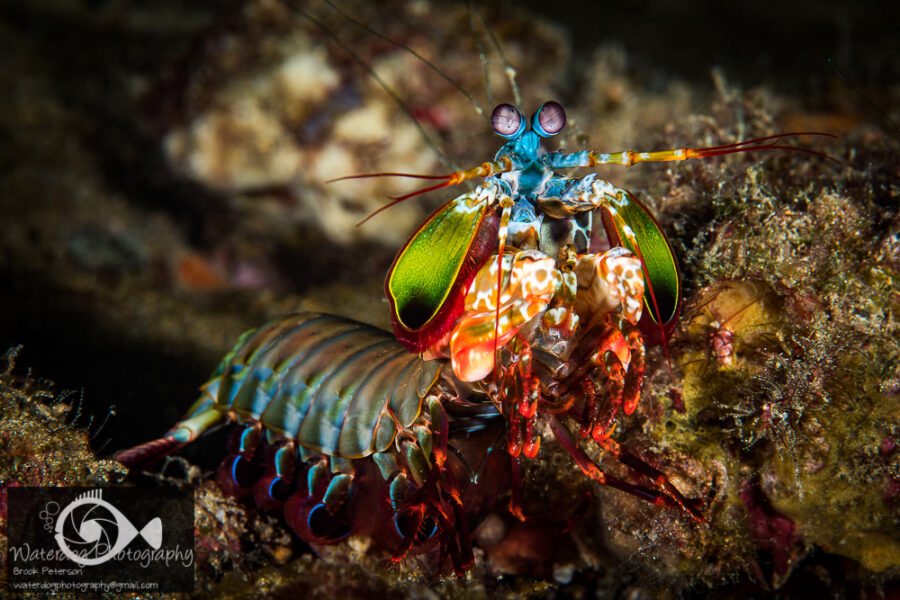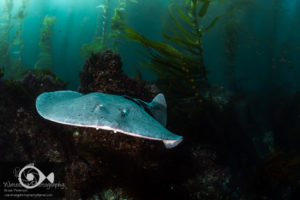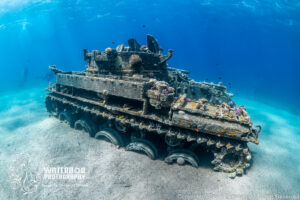Underwater Photographers love shrimp. And I don’t mean the fettuccini kind. As it turns out, there is an astounding variety of shrimp in our oceans and they are extremely varied in size, shape, and color.
One of the largest shrimp and arguably most beautiful sea creatures is the Peacock Mantis Shrimp.

These beautiful shrimp can be around six inches long although some species grow to 12 inches. They live in a burrow, but they will come out to hunt. The mantis shrimp have the most complex eyes in the animal kingdom. Their eyes move independently which is really fun to watch and a little crazy, and they can see ultra violet and polarized light with their exceptional eyesight.

The mantis shrimp can punch it’s prey with it’s front club-like arms with the speed of a .22 caliber bullet. They use punch this to smash the shells of their prey and some species have a spear-like appendage that they use to impale their prey.

On the smaller end of the mantis family is this tiny unidentified mantis shrimp. It is about a half an inch long, and has a clutch of eggs in its claws.

Another of the larger shrimp is the marble shrimp. This guy was about the size of my thumb. The patterns on this shrimp are beautiful and who wouldn’t want purple and white striped legs? Not to mention a fuzzy mane and claws!

Coleman shrimp are often found on the top of a fire urchin and their dark red spots and yellow carapace help them blend in with the colors of the urchin. They are usually found in pairs, with the female being the larger of the two.

The tiger shrimp is another beautifully colored and patterned animal. Its eyes are up on stalks and it spends its time hiding under rocks and shells so as not to be eaten by other predators.

A harlequin shrimp is a prize for any photographer. Its beautiful carapace helps it blend in to its environment and it’s front claws are like two large shields.

One of the most beautiful shrimp is the cleaner shrimp. This one lives in a symbiotic relationship with a goby. It keeps the goby’s burrow clean of rocks and small debris while the goby watches out for predators.

The Bumble Bee shrimp not only resembles a bumble-bee, but it moves around in a similar fashion, seeming to “fly” through the water.

A glass shrimp is almost completely transparent, and lives on hydroids or anemones where it feeds on planktonic organisms.

Crinoid shrimp are some of the most intriguing shrimp because they will take on the exact coloring of the crinoid they live in, (stripes and all). They can be a huge variety of colors, and they are only found on the crinoids in which they live. They feed on organisms that stick to the arms of the crinoid.

Whip coral shrimp are also found only on their host, the whip coral. It is unusual to find more than one or two on a whip coral so finding this colony of a dozen or so was exciting.

One of the tiniest and most cryptic shrimp is the hairy shrimp. This tiny animal is only a few millimeters and looks just like the algae filament that it lives in. They are sometimes called algae shrimp, and can be green, brown, or red, depending on the host.
These few images are hardly representative of the the vast number of species in the shrimp family, but they do give you an idea of the diversity that exists among them.
Subscribe now!
As always, if you enjoy my images please visit my website,waterdogphotography.com, or give me a like on facebook at Waterdog Photography Brook Peterson. Don’t forget to follow me here at waterdogphotographyblog and please feel free to share on Facebook or other social media.





